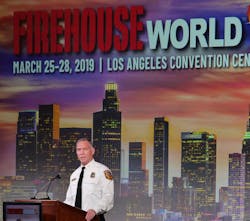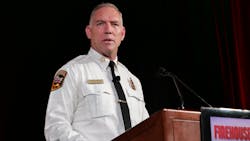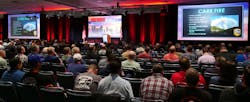FHWorld19: CAL FIRE Director Addresses Toll of Fighting ‘Career Fires’ Every Year
The deadly and destructive reality facing California's firefighters shows no signs of changing following several sobering years that included some of the worst wildfires in the state's history.
At the opening ceremony for Firehouse World 2019 in Los Angeles, CAL FIRE Director Thom Porter delivered an eye-opening keynote address that explored this painful reality head on and closed with a hopeful message for firefighters as they try to cope with the overwhelming nature of these incidents.
Porter, who was appointed Chief of CAL FIRE by newly elected Gov. Gavin Newsom in January, began by pointing out that while the state's wildfire reality has changed so much from the time when his career was first beginning, it's seen even more drastic change in just the last four years.
"I remember early in my career talking about career fires," Porter said. "What I remember talking about with a career fire was they were 60,000 to 70,000 acres and they may have burned 20 to 50 homes. And then the Tunnel Fire happened."
This incident marked the beginning of a steadily worsening situation that has now begun to break records year by year.
Following the incredible devastation visited upon California in 2017, which was capped by the then-record Thomas Fire, the following year saw an even greater amount of charred landscape and loss of life. Both the largest (Mendocino Complex Fire) and the deadliest and most destructive (Camp Fire) wildfires in state history happened last year.
"We're having career fires every month," Porter said. "Sometimes multiples in a month."
In 2018, there were over 7,500 wildfires—over 100 of them considered "significant"—that burned nearly 2 million acres, destroyed over 22,000 structures, and killed nearly 100 civilians and six firefighters. The total cost associated with all this devastation was more than $3.5 billion, including nearly $1.8 billion in fire suppression costs.
"We have seen conditions that have been critical at times and with a frequency that we have not seen before," Porter said, referring to weather conditions that have been devoid of any humidity and extremely dry, prolonging the peak portion of the fire season by about 75 days.
The longer and more intense fire seasons have led to multiple massive events happening in the same year. Porter focused on four wildfires from 2018 that made up a bulk of the destruction, showing time-lapse footage of how these fires grew out of control in such short periods of time:
- The Mendocino Complex Fire: 496,000 acres burned, 280 structures destroyed, 1 fatality.
- The Carr Fire: 229,000 acres burned, 1,600 structures destroyed, 8 fatalities.
- The Woolsey Fire: 96,000 acres burned, 1,600 structures destroyed, 3 fatalities.
- The Camp Fire: 153,000 acres burned, 18,800 structures destroyed, 85 fatalities.
Running through the numbers in terms of property and lives lost gave the proceedings a serious and somber tone for a large portion of the address, but Porter circled around to the men and women who fought to contain these fires and risked their lives to save others, particularly those who lost their own homes and nearly everything they owned while doing the job and trying to help.
The numbers bear out what an incredible undertaking it was to battle California's wildfires in 2018. There were over 236,000 personnel mobilized using over 22,600 pieces of apparatus, including bulldozers, and over 9,000 aircraft utilized across the state.
Porter mentioned a bulldozer operator he has spent some time with who, during the Camp Fire, was pushing cars out of the road that he was sure had victims in them just so others could escape, putting a painful face on the trauma first responders can carry beyond an incident.
"We're all doing this, and we're doing this way to often," Porter said. "The stress it's causing. We all have a cumulative effect from all of this, and it's taking a toll. A huge toll."
Porter closed by saying that although he never took mental strain and conditions like post-traumatic stress disorder (PTSD) into consideration early in his career, he now understands that these work-related stresses are having lasting impacts on everything from personal relationships to sleeping habits.
However, he honed in on how the greatest asset the fire service has is its people. If first responders can be there for each other from the leadership and officer positions on down to the rank-and-file, everyone will have a better chance to cope with what they see every day and go home safe after every shift.
"I don't want you to feel like this is hopeless," Porter said. "We can and we will band together and look out for each other. Take care of yourself. Take care of your family. And then take care of each other."
About the Author

John Kosik
John was the managing editor of Firehouse after joining the Firehouse team in April 2017 after spending most of his career in journalism writing and editing sports and music content for the Associated Press in New York City. Transitioning into coverage of the fire service industry was a move close to his heart with several friends and family members serving in the FDNY. He lives in Chicago.


